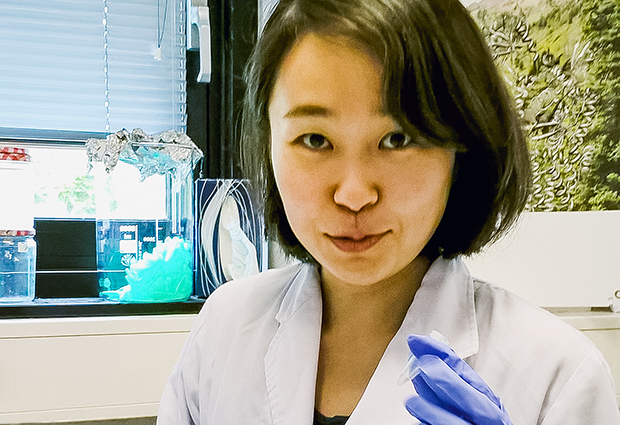
Read the latest Issue
For Emiko Uchikawa, a Japanese postdoc at EMBL in Grenoble, learning how vertebrates fight viruses helped her see her native country with different eyes

During infection, viruses strip themselves naked: they let their genetic material out of its protective capsid and into the infected cell’s cytoplasm or nucleus where it can be replicated. However, this can expose their genetic material to the watchful eye of the cell’s innate immune system which, upon detection of certain features only found in foreign nucleic acids, triggers an anti-viral response. Vertebrates recognise RNA-viruses thanks to receptors called Rig-I like receptors (RLRs), present in their cytoplasm. EMBL scientists recently described the detailed 3D structures of two of them, LGP2 and MDA5, in an article published in Molecular Cell.
For Emiko Uchikawa, the Japanese postdoctoral fellow who did most of the work, this finding is both an achievement and the starting point for further studies. It is also the result of her own successful combination of the Japanese and European ways to do research, and a trigger to compare them.
Uchikawa and her colleagues from the group of Stephen Cusack followed several steps in this project: first they crystallised the two molecules in their different states – bound to the viral RNA or not – then analysed the crystals with X-rays at the ESRF synchrotron. Each step required very specialised and advanced technology that one institution alone cannot maintain. “EMBL in Grenoble is part of the Partnership for Structural Biology (PSB), which gives scientists easy access to different institutions with complementary technologies in structural biology across the European Photon and Neutrino science (EPN) campus. This makes work so much easier and more efficient,” explains Uchikawa. “Networks like the PSB do not exist in Japan: people and groups like to be self-sufficient, rather than using collaborative platforms like here.”
According to Uchikawa, this independence stems from a deep cultural difference: like most Japanese employees, scientists not only try to provide for their own needs, they also work very long hours and rarely go on holiday. “The good thing is that there is always someone in the lab to give advice or support, whatever the time,” adds Uchikawa. “Having to make appointments with people when I needed help was something new to me when I arrived in France, but I got quickly used to it.”
There is always someone in the lab to give advice or support, whatever the time. Having to make appointments with people when I needed help was something new to me
The French, and European, systems work very differently: scientists also work long hours but they still save time for their private lives and, most importantly, regularly go on holiday for two or three weeks in a row. Their Japanese peers, by contrast, generally only take a break during the official public holidays organised every month.
Uchikawa is interested to observe that the productivity and efficiency of both systems are equal. “The collaborative way that scientists work in Europe, and particularly at EMBL — sharing resources and knowledge via technological platforms where people are extremely knowledgeable about a specific topic — speeds up the experiments so much that it compensates for the fact that people may work less hours overall,” she explains. “So, in general, people here have a better work-life balance and are equally good in science.”
Having lived in France for six years, Uchikawa feels she has “shifted” culturally in a way that has helped opened her mind. Being part of a “minority” and consequently having to adapt was her first, and main, learning experience. “I think that more Japanese people should travel and see how other countries do things in general,” she says. “But this is valid for everybody: I consider that moving abroad and working in an international environment has helped me both as a person, and as a scientist.”
Going beyond her team’s recent publication, scientific curiosity is now driving Uchikawa to elucidate the exact mechanism underlying the immune response after the recognition of viral RNA by LGP-2 and MDA5 – with the help of many colleagues from across the EPN campus…
Looking for past print editions of EMBLetc.? Browse our archive, going back 20 years.
EMBLetc. archive